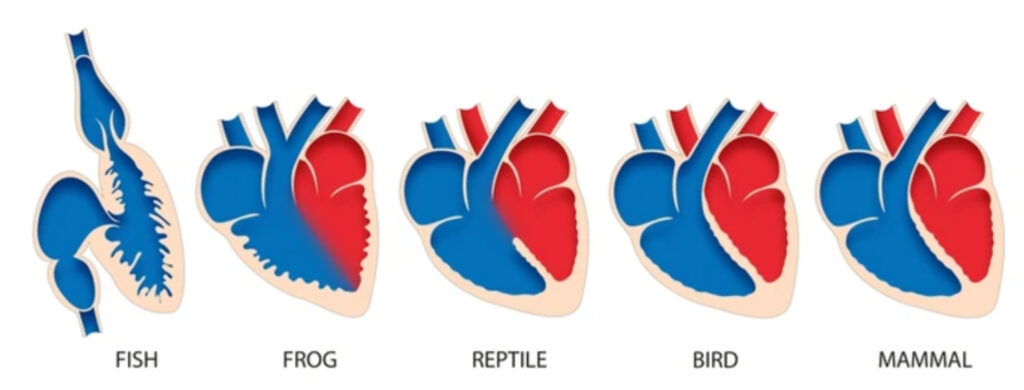INTRODUCTION
The circulatory system of teleosts, or bony fish, is a marvel of efficiency and adaptation, evolved over millions of years to support their aquatic lifestyle. This system ensures the delivery of oxygen and nutrients throughout the body while removing waste products, playing a crucial role in their survival. In this essay, we will explore the intricacies of the blood circulatory system in teleosts, focusing on its structure, function, adaptations, and evolutionary significance.
STRUCTURE OF THE CIRCULATORY SYSTEM

The circulatory system of teleosts consists of a heart, blood vessels, and blood. The heart is typically two-chambered, composed of an atrium and a ventricle, although some species may have variations such as a partial septum or additional accessory chambers. Blood vessels are categorized into arteries, which carry oxygenated blood away from the heart, and veins, which return deoxygenated blood back to the heart.Teleosts have a single systemic circuit, where blood travels from the heart to the gills for oxygenation and then to the rest of the body tissues before returning to the heart. Unlike mammals, they lack a pulmonary circuit because gas exchange occurs exclusively in the gills.
FUNCTION OF THE CIRCULATORY SYSTEM IN TELEOSTS
The primary functions of the circulatory system in teleosts include
Oxygen Transport: Blood picks up oxygen from the gills and delivers it to tissues throughout the body, facilitating cellular respiration.
Nutrient Transport: Nutrients absorbed from the digestive system are transported via the bloodstream to various tissues for growth, repair, and energy production.
Waste Removal: Deoxygenated blood carrying metabolic waste products such as carbon dioxide is transported back to the gills and kidneys for elimination.
Hormone Transport: Circulating hormones regulate various physiological processes in teleosts, including growth, reproduction, and metabolism.
Temperature Regulation: In some species, blood circulation helps regulate body temperature, although teleosts are generally ectothermic and rely on environmental temperature regulation.
ADAPTATIONS OF THE CIRCULATORY SYSTEM IN TELEOSTS

Teleosts have several adaptations that optimize their circulatory efficiency:
Gill Structure: Teleosts have highly specialized gills with a large surface area for efficient gas exchange. Countercurrent exchange mechanisms in the gill lamellae ensure maximum oxygen absorption and carbon dioxide removal.
Cardiac Efficiency: Despite having a two-chambered heart, teleosts have adaptations like the bulbus arteriosus (a muscular arterial sac) and efficient cardiac muscle structure to maintain circulation under varying pressures and oxygen demands.
Blood Composition: Teleosts typically have nucleated red blood cells (erythrocytes), which aids in gas transport and adaptation to different oxygen levels in water.
Circulatory Patterns: Some teleosts exhibit specialized circulatory patterns during activities like diving or fast swimming, where blood flow can be redirected to specific organs or muscles as needed.
Osmoregulation: In freshwater and marine teleosts, specialized adaptations in the circulatory system facilitate the regulation of water and ion balance, crucial for maintaining internal homeostasis.
EVOLUTIONARY SIGNIFICANCE
The evolution of the circulatory system in teleosts has been shaped by their transition from aquatic ancestors to modern species occupying diverse ecological niches:
Water-to-Land Transition: As teleosts evolved from aquatic environments, their circulatory systems adapted to meet the challenges of terrestrial life, including gravity and changes in oxygen availability.
Diversity of Habitats: Teleosts inhabit a wide range of aquatic environments, from shallow rivers to deep oceans, leading to adaptations in heart size, blood composition, and vascular patterns
CONCLUSION
The blood circulatory system of teleosts is a marvel of evolutionary adaptation, finely tuned to meet the metabolic demands and environmental challenges of aquatic life. Through efficient oxygen transport, nutrient distribution, waste removal, and regulatory mechanisms, this system supports the survival and diverse lifestyles of teleosts across the world’s oceans, rivers, and lakes. Understanding the intricacies of their circulatory system provides insights into the remarkable adaptations that enable teleosts to thrive in their aquatic habitats.
Discover more from ZOOLOGYTALKS
Subscribe to get the latest posts sent to your email.


